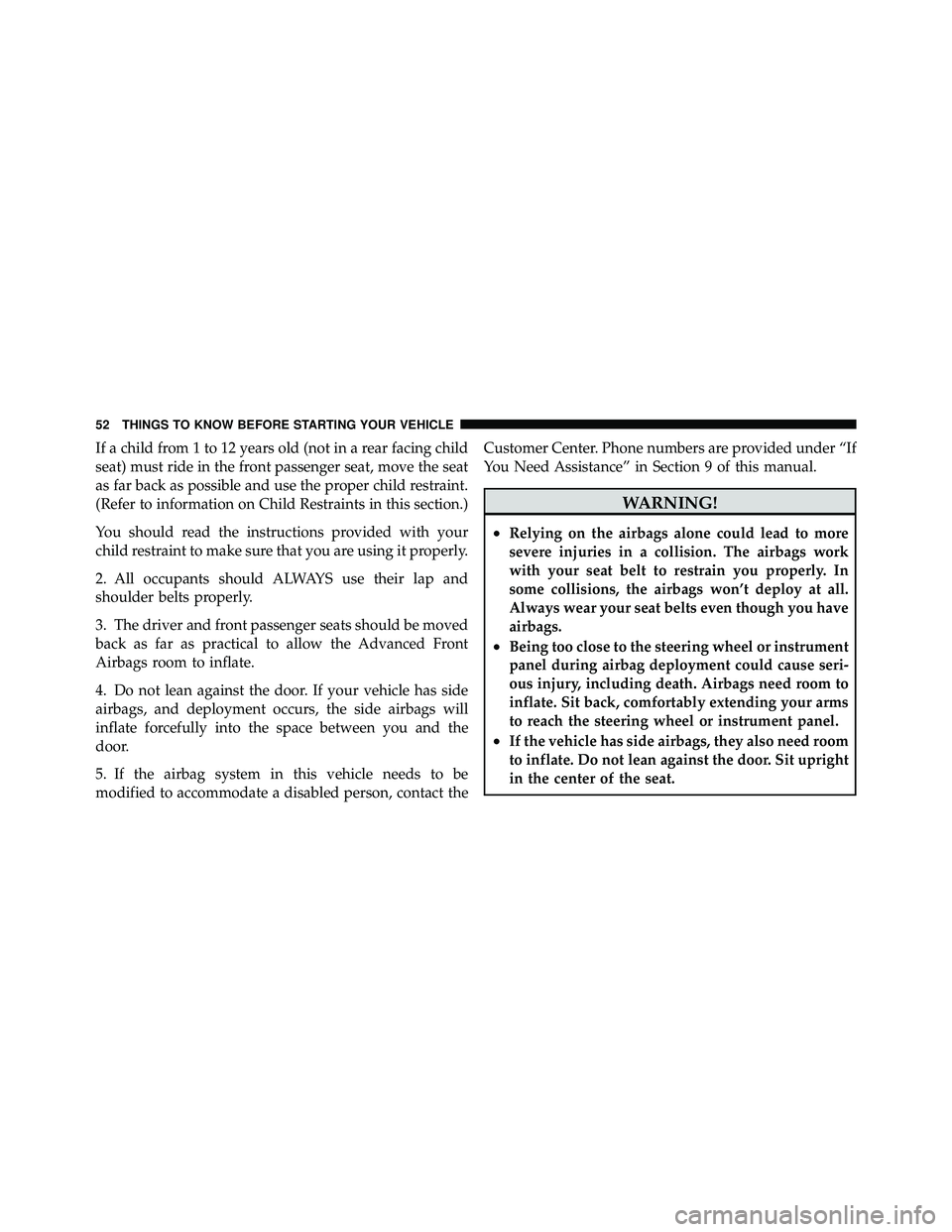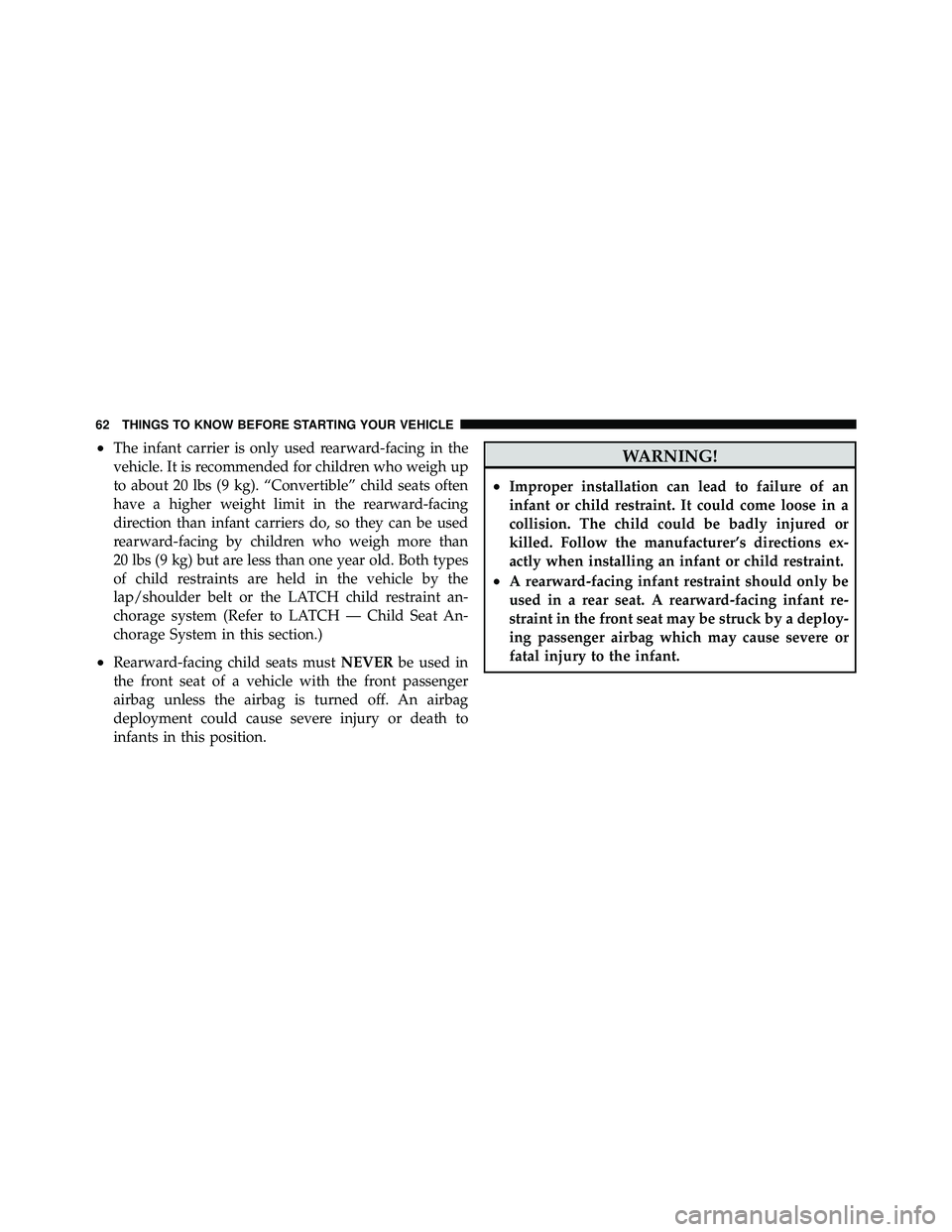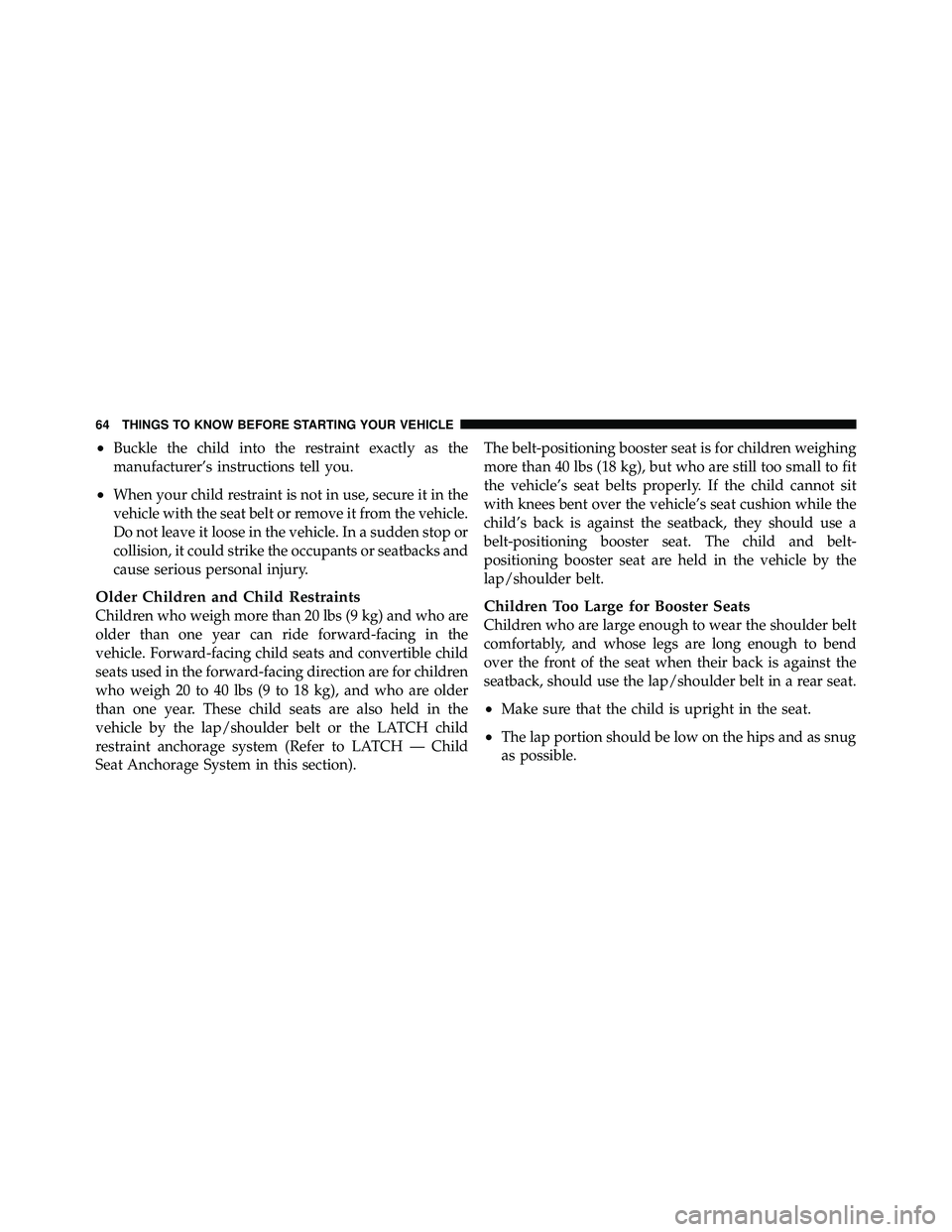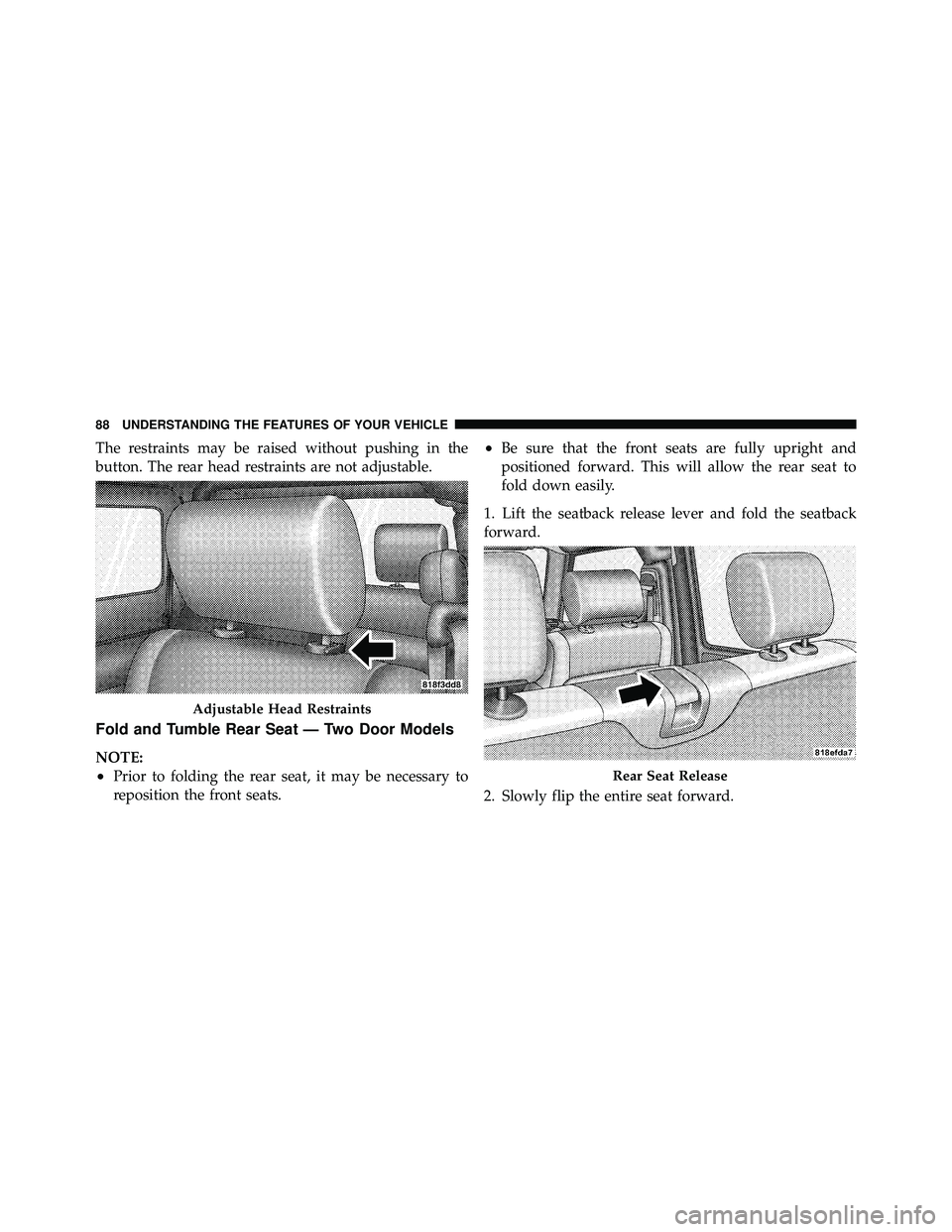seats JEEP WRANGLER 2009 Owners Manual
[x] Cancel search | Manufacturer: JEEP, Model Year: 2009, Model line: WRANGLER, Model: JEEP WRANGLER 2009Pages: 502, PDF Size: 13.82 MB
Page 42 of 502

WARNING! (Continued)
•Do not allow people to ride in any area of your
vehicle that is not equipped with seats and seat
belts.
•Be sure everyone in your vehicle is in a seat using
a seat belt properly.
•Wearing a seat belt incorrectly is dangerous. Seat
belts are designed to go around the large bones of
your body. These are the strongest parts of your
body and take the forces of a collision the best.
Wearing your belt in the wrong place could make
your injuries in a collision much worse. You might
suffer internal injuries, or you could even slide out
of part of the belt. Follow these instructions to
wear your seat belt safely and to keep your pas-
sengers safe, too.(Continued)
Page 52 of 502

If the vehicle is equipped with side airbags, they are
located inside the driver and front passenger seats, and
their covers are also labeled SRS.
NOTE:Airbag covers may not be obvious in the interior
trim; but they will open during airbag deployment.
Page 54 of 502

If a child from 1 to 12 years old (not in a rear facing child
seat) must ride in the front passenger seat, move the seat
as far back as possible and use the proper child restraint.
(Refer to information on Child Restraints in this section.)
You should read the instructions provided with your
child restraint to make sure that you are using it properly.
2. All occupants should ALWAYS use their lap and
shoulder belts properly.
3. The driver and front passenger seats should be moved
back as far as practical to allow the Advanced Front
Airbags room to inflate.
4. Do not lean against the door. If your vehicle has side
airbags, and deployment occurs, the side airbags will
inflate forcefully into the space between you and the
door.
5. If the airbag system in this vehicle needs to be
modified to accommodate a disabled person, contact theCustomer Center. Phone numbers are provided under “If
You Need Assistance” in Section 9 of this manual.
Page 64 of 502

•The infant carrier is only used rearward-facing in the
vehicle. It is recommended for children who weigh up
to about 20 lbs (9 kg). “Convertible” child seats often
have a higher weight limit in the rearward-facing
direction than infant carriers do, so they can be used
rearward-facing by children who weigh more than
20 lbs (9 kg) but are less than one year old. Both types
of child restraints are held in the vehicle by the
lap/shoulder belt or the LATCH child restraint an-
chorage system (Refer to LATCH — Child Seat An-
chorage System in this section.)
•Rearward-facing child seats mustNEVERbe used in
the front seat of a vehicle with the front passenger
airbag unless the airbag is turned off. An airbag
deployment could cause severe injury or death to
infants in this position.
Page 66 of 502

•Buckle the child into the restraint exactly as the
manufacturer’s instructions tell you.
•When your child restraint is not in use, secure it in the
vehicle with the seat belt or remove it from the vehicle.
Do not leave it loose in the vehicle. In a sudden stop or
collision, it could strike the occupants or seatbacks and
cause serious personal injury.
Older Children and Child Restraints
Children who weigh more than 20 lbs (9 kg) and who are
older than one year can ride forward-facing in the
vehicle. Forward-facing child seats and convertible child
seats used in the forward-facing direction are for children
who weigh 20 to 40 lbs (9 to 18 kg), and who are older
than one year. These child seats are also held in the
vehicle by the lap/shoulder belt or the LATCH child
restraint anchorage system (Refer to LATCH — Child
Seat Anchorage System in this section).The belt-positioning booster seat is for children weighing
more than 40 lbs (18 kg), but who are still too small to fit
the vehicle’s seat belts properly. If the child cannot sit
with knees bent over the vehicle’s seat cushion while the
child’s back is against the seatback, they should use a
belt-positioning booster seat. The child and belt-
positioning booster seat are held in the vehicle by the
lap/shoulder belt.Children Too Large for Booster Seats
Children who are large enough to wear the shoulder belt
comfortably, and whose legs are long enough to bend
over the front of the seat when their back is against the
seatback, should use the lap/shoulder belt in a rear seat.
•Make sure that the child is upright in the seat.
•The lap portion should be low on the hips and as snug
as possible.
64 THINGS TO KNOW BEFORE STARTING YOUR VEHICLE
Page 90 of 502

The restraints may be raised without pushing in the
button. The rear head restraints are not adjustable.
Fold and Tumble Rear Seat — Two Door Models
NOTE:
•Prior to folding the rear seat, it may be necessary to
reposition the front seats.
•Be sure that the front seats are fully upright and
positioned forward. This will allow the rear seat to
fold down easily.
1. Lift the seatback release lever and fold the seatback
forward.
2. Slowly flip the entire seat forward.
Page 496 of 502

Reminder............................ 201
Seats ................................. 83
Adjustment ........................... 83
Easy Entry ............................ 85
Fold and Tumble Rear ................... 88
Head Restraints ........................ 87
Height Adjustment ...................... 84
Rear Folding .......................... 91
Removal ........................... 89,91
Seatback Release ....................... 85
Tilting ............................... 85
Security Against Theft ..................... 17
Security Alarm (Theft Alarm) ................ 17
Selection of Oil ......................... 407
Sentry Key (Immobilizer) ................... 14
Sentry Key Programming ................... 16
Sentry Key Replacement ................... 15
Service Assistance ....................... 473
Service Contract ......................... 475 Service Manuals
........................ 477
Setting the Clock ................ 220,234,238,247
Shift Lock Manual Override ................ 286
Shifting ............................... 285
Automatic Transmission ................. 287
Manual Transmission ................... 281
Shoulder Belt Upper Anchorage .............. 45
Shoulder Belts ........................... 39
Side Airbag ............................. 55
Signals, Turn ................. 76,96,201,445,446
Snow Chains (Tire Chains) ................. 350
Soft Top ........................... 131,153
Spare Tire ............................. 390
Specifications Fuel (Gasoline) ........................ 356
Oil ................................ 407
Speed Control (Cruise Control) .............. 102
Speedometer ........................... 200
Starting ............................... 277
494 INDEX